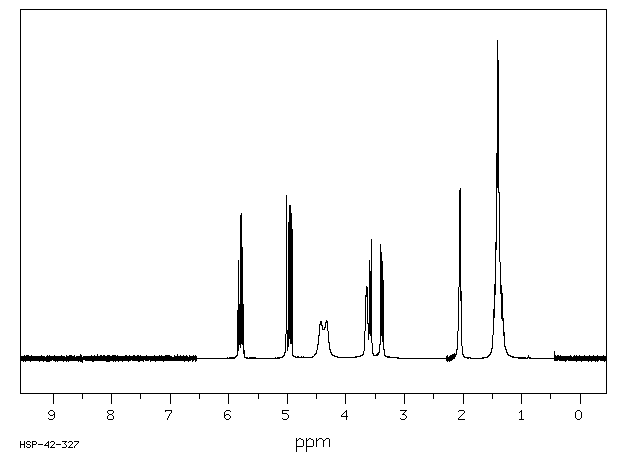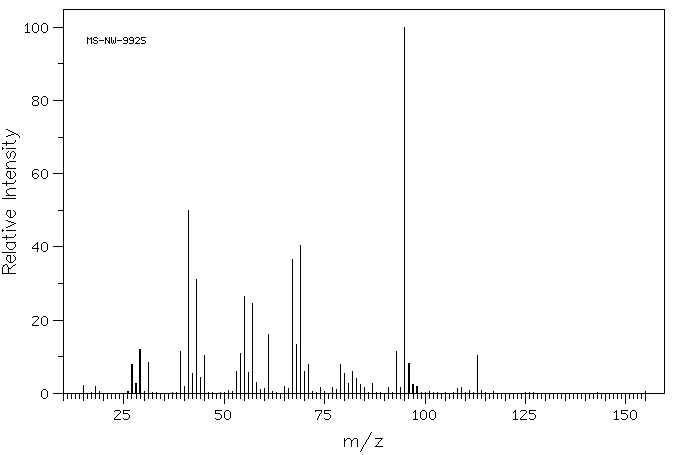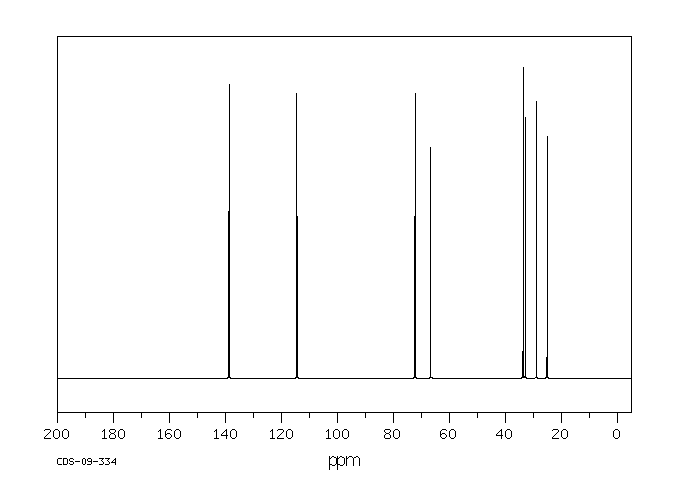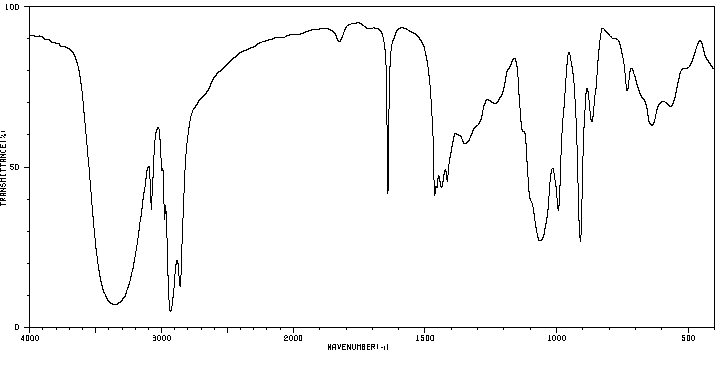7,8-二羟基-1-辛烯 | 85866-02-0
中文名称
7,8-二羟基-1-辛烯
中文别名
7-辛烯-1,2-二醇
英文名称
7-octene-1,2-diol
英文别名
7,8-dihydroxy-1-octene;oct-7-ene-1,2-diol;7-octen-1,2-diol
CAS
85866-02-0
化学式
C8H16O2
mdl
MFCD00012060
分子量
144.214
InChiKey
UXGHWJFURBQKCJ-UHFFFAOYSA-N
BEILSTEIN
——
EINECS
——
-
物化性质
-
计算性质
-
ADMET
-
安全信息
-
SDS
-
制备方法与用途
-
上下游信息
-
文献信息
-
表征谱图
-
同类化合物
-
相关功能分类
-
相关结构分类
物化性质
-
沸点:256.0±28.0 °C(Predicted)
-
密度:0.941 g/mL at 25 °C (lit.)
-
闪点:113 °C
-
稳定性/保质期:
如果按照规格正确使用和储存,则不会分解,也未有已知危险反应。
计算性质
-
辛醇/水分配系数(LogP):1.3
-
重原子数:10
-
可旋转键数:6
-
环数:0.0
-
sp3杂化的碳原子比例:0.75
-
拓扑面积:40.5
-
氢给体数:2
-
氢受体数:2
安全信息
-
海关编码:2905399090
-
WGK Germany:3
-
储存条件:请将贮藏器密封,并将其存放在阴凉、干燥处。同时,确保工作环境有良好的通风或排气设施。
SDS
Section 1. IDENTIFICATION OF THE SUBSTANCE/MIXTURE
Product identifiers
Product name : 7-Octene-1,2-diol
CAS-No. : 85866-02-0
Relevant identified uses of the substance or mixture and uses advised against
Identified uses : Laboratory chemicals, Manufacture of substances
Section 2. HAZARDS IDENTIFICATION
Classification of the substance or mixture
Not a hazardous substance or mixture according to Regulation (EC) No. 1272/2008.
This substance is not classified as dangerous according to Directive 67/548/EEC.
Label elements
The product does not need to be labelled in accordance with EC directives or respective national laws.
Other hazards - none
Section 3. COMPOSITION/INFORMATION ON INGREDIENTS
Substances
Formula : C8H16O2
Molecular Weight : 144,21 g/mol
Section 4. FIRST AID MEASURES
Description of first aid measures
If inhaled
If breathed in, move person into fresh air. If not breathing, give artificial respiration.
In case of skin contact
Wash off with soap and plenty of water.
In case of eye contact
Flush eyes with water as a precaution.
If swallowed
Never give anything by mouth to an unconscious person. Rinse mouth with water.
Most important symptoms and effects, both acute and delayed
Indication of any immediate medical attention and special treatment needed
no data available
Section 5. FIREFIGHTING MEASURES
Extinguishing media
Suitable extinguishing media
Use water spray, alcohol-resistant foam, dry chemical or carbon dioxide.
Special hazards arising from the substance or mixture
Carbon oxides
Advice for firefighters
Wear self contained breathing apparatus for fire fighting if necessary.
Further information
no data available
Section 6. ACCIDENTAL RELEASE MEASURES
Personal precautions, protective equipment and emergency procedures
Avoid breathing vapors, mist or gas.
Environmental precautions
Do not let product enter drains.
Methods and materials for containment and cleaning up
Keep in suitable, closed containers for disposal.
Reference to other sections
For disposal see section 13.
Section 7. HANDLING AND STORAGE
Precautions for safe handling
Normal measures for preventive fire protection.
Conditions for safe storage, including any incompatibilities
Store in cool place. Keep container tightly closed in a dry and well-ventilated place. Containers which are
opened must be carefully resealed and kept upright to prevent leakage.
hygroscopic
Specific end uses
no data available
Section 8. EXPOSURE CONTROLS/PERSONAL PROTECTION
Control parameters
Components with workplace control parameters
Exposure controls
Appropriate engineering controls
General industrial hygiene practice.
Personal protective equipment
Eye/face protection
Use equipment for eye protection tested and approved under appropriate government standards
such as NIOSH (US) or EN 166(EU).
Skin protection
Handle with gloves. Gloves must be inspected prior to use. Use proper glove removal technique
(without touching glove's outer surface) to avoid skin contact with this product. Dispose of
contaminated gloves after use in accordance with applicable laws and good laboratory practices.
Wash and dry hands.
The selected protective gloves have to satisfy the specifications of EU Directive 89/686/EEC and
the standard EN 374 derived from it.
Body Protection
impervious clothing, The type of protective equipment must be selected according to the
concentration and amount of the dangerous substance at the specific workplace.
Respiratory protection
Respiratory protection not required. For nuisance exposures use type OV/AG (US) or type ABEK
(EU EN 14387) respirator cartridges. Use respirators and components tested and approved under
appropriate government standards such as NIOSH (US) or CEN (EU).
Section 9. PHYSICAL AND CHEMICAL PROPERTIES
Information on basic physical and chemical properties
a) Appearance Form: liquid
b) Odour no data available
c) Odour Threshold no data available
d) pH no data available
e) Melting point/freezing no data available
point
f) Initial boiling point and no data available
boiling range
g) Flash point > 113,00 °C - closed cup
h) Evaporation rate no data available
i) Flammability (solid, gas) no data available
j) Upper/lower no data available
flammability or
explosive limits
k) Vapour pressure no data available
l) Vapour density no data available
m) Relative density 0,941 g/mL at 25 °C
n) Water solubility no data available
o) Partition coefficient: n- no data available
octanol/water
p) Autoignition no data available
temperature
q) Decomposition no data available
temperature
r) Viscosity no data available
s) Explosive properties no data available
t) Oxidizing properties no data available
Other safety information
no data available
Section 10. STABILITY AND REACTIVITY
Reactivity
no data available
Chemical stability
no data available
Possibility of hazardous reactions
no data available
Conditions to avoid
no data available
Incompatible materials
Strong oxidizing agents
Hazardous decomposition products
Other decomposition products - no data available
Section 11. TOXICOLOGICAL INFORMATION
Information on toxicological effects
Acute toxicity
no data available
Skin corrosion/irritation
no data available
Serious eye damage/eye irritation
no data available
Respiratory or skin sensitization
no data available
Germ cell mutagenicity
no data available
Carcinogenicity
IARC: No component of this product present at levels greater than or equal to 0.1% is identified as
probable, possible or confirmed human carcinogen by IARC.
Reproductive toxicity
no data available
Specific target organ toxicity - single exposure
no data available
Specific target organ toxicity - repeated exposure
no data available
Aspiration hazard
no data available
Potential health effects
Inhalation
May be harmful if inhaled. May cause respiratory tract irritation.
Ingestion May be harmful if swallowed.
Skin May be harmful if absorbed through skin. May cause skin irritation.
Eyes May cause eye irritation.
Additional Information
RTECS: Not available
Section 12. ECOLOGICAL INFORMATION
Toxicity
no data available
Persistence and degradability
no data available
Bioaccumulative potential
no data available
Mobility in soil
no data available
Results of PBT and vPvB assessment
no data available
Other adverse effects
no data available
Section 13. DISPOSAL CONSIDERATIONS
Waste treatment methods
Product
Offer surplus and non-recyclable solutions to a licensed disposal company.
Contaminated packaging
Dispose of as unused product.
Section 14. TRANSPORT INFORMATION
UN number
ADR/RID: - IMDG: - IATA: -
UN proper shipping name
ADR/RID: Not dangerous goods
IMDG: Not dangerous goods
IATA: Not dangerous goods
Transport hazard class(es)
ADR/RID: - IMDG: - IATA: -
Packaging group
ADR/RID: - IMDG: - IATA: -
Environmental hazards
ADR/RID: no IMDG Marine pollutant: no IATA: no
Special precautions for user
no data available
SECTION 15 - REGULATORY INFORMATION
N/A
SECTION 16 - ADDITIONAL INFORMATION
N/A
上下游信息
-
上游原料
中文名称 英文名称 CAS号 化学式 分子量 1,2-环氧-7-辛烯 1,2-epoxy-7-octene 19600-63-6 C8H14O 126.199 -
下游产品
中文名称 英文名称 CAS号 化学式 分子量 —— 8-hydroxy-7-methoxy-1-octene 127164-70-9 C9H18O2 158.241 7,8-二甲氧基辛-1-烯 7,8-Dimethoxyoct-1-ene 93840-75-6 C10H20O2 172.26 6-庚烯-1-醇 6-hepten-1-ol 4117-10-6 C7H14O 114.188 —— (2R,3R)-(3-hex-5-enyloxiranyl)methanol 852820-74-7 C9H16O2 156.225
反应信息
-
作为反应物:描述:7,8-二羟基-1-辛烯 在 1,2-bis[(2S,5S)-2,5-diethylphospholano]benzene(1,5-cyclooctadiene)rhodium(I) trifluoromethanesulfonate 盐酸 、 4-二甲氨基吡啶 、 sodium periodate 、 偶氮二甲酸二异丙酯 、 氢气 、 O-(benzotriazol-1-yl)-N,N,N',N'-tetramethyluronium tetrafluoroborate 、 三乙胺 、 N,N-二异丙基乙胺 、 三苯基膦 作用下, 以 四氢呋喃 、 1,4-二氧六环 、 吡啶 、 乙醇 、 二氯甲烷 、 水 为溶剂, 20.0 ℃ 、310.26 kPa 条件下, 反应 89.0h, 生成 (Z)-(1S,4R,6S,14S,18R)-14-Cyclopentyloxycarbonylamino-18-(7-methoxy-2-methoxycarbonyl-quinolin-4-yloxy)-2,15-dioxo-3,16-diaza-tricyclo[14.3.0.04,6]nonadec-7-ene-4-carboxylic acid methyl ester参考文献:名称:Synthesis of BILN 2061, an HCV NS3 Protease Inhibitor with Proven Antiviral Effect in Humans摘要:The synthesis of BILN 2061, an NS3 protease inhibitor with proven antiviral effect in humans, was accomplished in a convergent manner from four building blocks. The procedure described here was suitable for the preparation of multigram quantities of BILN 2061 for preclinical pharmacological evaluation.DOI:10.1021/ol0489907
-
作为产物:参考文献:名称:Byrom, Norman T.; Grigg, Ronald; Kongkathip, Boonsong, Journal of the Chemical Society. Perkin transactions I, 1984, # 8, p. 1643 - 1653摘要:DOI:
文献信息
-
Halogen substituted metallocene compounds for olefin polymerization申请人:Voskoboynikov Z. Alexander公开号:US20070135594A1公开(公告)日:2007-06-14A metallocene compound is represented by the formula (1): AMX n-1 wherein M is a transition metal atom having a coordination number of n selected from Group 3, 4, 5 or 6 of the Periodic Table of Elements, or a lanthanide metal atom, or actinide metal atom; A is a substituted monocyclic or polycyclic arenyl ligand pi-bonded to M, wherein said arenyl ligand includes at least one halogen substituent directly bonded to any sp 2 carbon atom at a bondable ring position of the ligand; and the or each X is a univalent anionic ligand, or two X are joined and bound to the metal atom to form a metallocycle ring, or two X are joined to form a chelating ligand, a diene ligand, or an alkylidene ligand.
-
Ruthenium-Catalyzed Vinylsilane Synthesis and Cross-Coupling as a Selective Approach to Alkenes: Benzyldimethylsilyl as a Robust Vinylmetal Functionality作者:Barry M. Trost、Michelle R. Machacek、Zachary T. BallDOI:10.1021/ol034463w日期:2003.5.1[reaction: see text] Ruthenium-catalyzed alkyne hydrosilylation or silyl-alkyne Alder ene reactions provide entry into benzyldimethylsilyl (BDMS)-substituted alkenes. The BDMS-vinylsilanes are further elaborated through mild palladium-catalyzed cross coupling and show significant stability to intervening synthetic operations, including silyl ether deprotection.
-
DERMATOLOGICAL COMPOSITIONS AND METHODS申请人:——公开号:US20020141952A1公开(公告)日:2002-10-03Disclosed are methods and compositions for regulating the melanin content of mammalian melanocytes; regulating pigmentation in mammalian skin, hair, wool or fur; treating or preventing various skin and proliferative disorders; by administration of various compounds, including alcohols, diols and/or triols and their analogues.公开了用于调节哺乳动物黑素细胞的黑色素含量的方法及组合物;通过施用包括醇、二醇和/或三醇及其类似物在内的各种化合物,来调节哺乳动物皮肤、毛发、羊毛或毛皮的色素沉着;以及治疗或预防各种皮肤和增殖性障碍。
-
Ruthenium pincer-catalyzed synthesis of substituted γ-butyrolactones using hydrogen autotransfer methodology
-
[EN] TRANSITION METAL COMPOUNDS FOR OLEFIN POLYMERIZATION AND OLIGOMERIZATION<br/>[FR] COMPOSES METALLIQUES DE TRANSITION POUR LA POLYMERISATION D'OLEFINES ET L'OLIGOMERISATION申请人:EXXONMOBIL CHEM PATENTS INC公开号:WO2005118605A1公开(公告)日:2005-12-15This invention relates to new transition metal catalyst compounds represented by the formula (I): where: M and M' are, independently, a group 8, 9, 10 or 11 transition metal, preferably Ni, Co, Pd, Cu or Fe; each R group is, independently, is, hydrogen, or a hydrocarbyl, substituted hydrocarbyl, halocarbyl, substituted halocarbyl, silylcarbyl, substituted silylcarbyl, germylcarbyl, or substituted germylcarbyl substituents, and optionally, adjacent R groups may join together to form a substituted or unsubstituted, saturated, partially unsaturated, or aromatic cyclic or polycyclic substituent; R' is hydrogen, or a hydrocarbyl, substituted hydrocarbyl, halocarbyl, substituted halocarbyl, silylcarbyl, substituted silylcarbyl, germylcarbyl, or substituted germylcarbyl substituents, and optionally, adjacent R groups may join together with R' to form a substituted or unsubstituted, saturated, partially unsaturated, or aromatic cyclic or polycyclic substituent; each X group is, independently, is, hydrogen, a halogen, or a hydrocarbyl, substituted hydrocarbyl, halocarbyl, substituted halocarbyl, silylcarbyl, substituted sililcarbyl, germylcarbyl, or substituted germylcarbyl substituents, and optionally, adjacent X groups may join together to form a substituted or unsubstituted, saturated, partially unsaturated, or aromatic cyclic or polycyclic substituent; m and m’ are, independently, 0, 1, 2, or 3; z and z’ are, independently, 0, 1, 2, or 3; N is nitrogen; Q is hydrogen, or a hydrocarbyl, substituted hydrocarbyl, halocarbyl, substituted halocarbyl, silylcarbyl, substituted silylcarbyl, germylcarbyl, or substituted germylcarbyl substituents; Q’ is hydrogen, or a hydrocarbyl, substituted hydrocarbyl, halocarbyl, substituted halocarbyl, silylcarbyl, substituted silylcarbyl, germylcarbyl or substituted germylcarbyl substituents; and L is a hydrocarbyl, substituted hydrocarbyl, halocarbyl, substituted halocarbyl, silylcarbyl, substituted silylcarbyl, germylcarbyl, or substituted germylcarbyl substituent.这项发明涉及由式(I)表示的新过渡金属催化剂化合物,其中:M和M'分别是8、9、10或11族过渡金属,优选为Ni、Co、Pd、Cu或Fe;每个R基分别是氢,或烃基,取代烃基,卤代烃基,取代卤代烃基,硅烃基,取代硅烃基,锗烃基,或取代锗烃基取代基,且可选地,相邻的R基可以结合在一起形成取代或未取代的饱和、部分不饱和或芳香环或多环取代基;R'是氢,或烃基,取代烃基,卤代烃基,取代卤代烃基,硅烃基,取代硅烃基,锗烃基,或取代锗烃基取代基,且可选地,相邻的R基可以与R'结合在一起形成取代或未取代的饱和、部分不饱和或芳香环或多环取代基;每个X基分别是氢,卤素,或烃基,取代烃基,卤代烃基,取代卤代烃基,硅烃基,取代硅烃基,锗烃基,或取代锗烃基取代基,且可选地,相邻的X基可以结合在一起形成取代或未取代的饱和、部分不饱和或芳香环或多环取代基;m和m'分别为0、1、2或3;z和z'分别为0、1、2或3;N为氮;Q为氢,或烃基,取代烃基,卤代烃基,取代卤代烃基,硅烃基,取代硅烃基,锗烃基,或取代锗烃基取代基;Q'为氢,或烃基,取代烃基,卤代烃基,取代卤代烃基,硅烃基,取代硅烃基,锗烃基,或取代锗烃基取代基;L为烃基,取代烃基,卤代烃基,取代卤代烃基,硅烃基,取代硅烃基,锗烃基,或取代锗烃基取代基。
表征谱图
-
氢谱1HNMR
-
质谱MS
-
碳谱13CNMR
-
红外IR
-
拉曼Raman
-
峰位数据
-
峰位匹配
-
表征信息
同类化合物
(±)17,18-二HETE
(±)-辛酰肉碱氯化物
(Z)-5-辛烯甲酯
(Z)-4-辛烯酸
(R)-甲羟戊酸锂盐
(R)-普鲁前列素,游离酸
(R,R)-半乳糖苷
(E)-4-庚烯酸
(E)-4-壬烯酸
(E)-4-十一烯酸
(9Z,12E)-十八烷二烯酸甲酯
(6E)-8-甲基--6-壬烯酸甲基酯-d3
(3R,6S)-rel-8-[2-(3-呋喃基)-1,3-二氧戊环-2-基]-3-羟基-2,6-二甲基-4-辛酮
龙胆二糖
黑曲霉二糖
黄质霉素
麦芽酮糖一水合物
麦芽糖醇
麦芽糖酸
麦芽糖基蔗糖
麦芽糖一水合物
麦芽糖
鳄梨油酸乙酯
鲸蜡醇蓖麻油酸酯
鲸蜡醇油酸酯
鲸蜡硬脂醇硬脂酸酯
鲸蜡烯酸脂
鲸蜡基花生醇
鲫鱼酸
鲁比前列素
鲁比前列素
高级烷基C16-18-醇
高甲羟戊酸
高效氯氰菊酯
高-gamma-亚油酸
马来酸烯丙酯
马来酸氢异丙酯
马来酸氢异丁酯
马来酸氢丙酯
马来酸氢1-[2-(2-羟基乙氧基)乙基]酯
马来酸单乙酯
马来酸单丁酯
马来酸二辛酯
马来酸二癸酯
马来酸二甲酯
马来酸二烯丙酯
马来酸二正丙酯
马来酸二戊基酯
马来酸二异壬酯
马来酸二异丙酯











